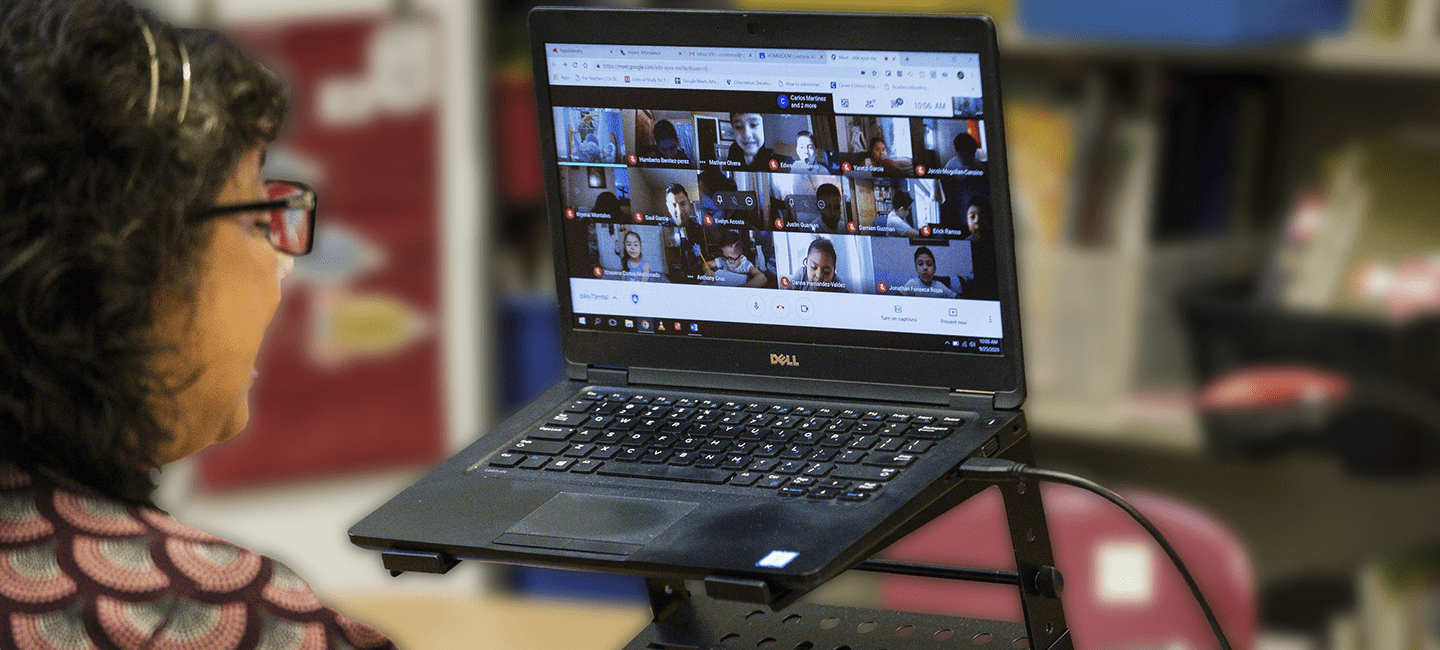
En la escuela primaria Saucedo de Little Village, Olga Contreras lucha contra la pérdida palpable de aprendizaje, día a día y alumno a alumno.
Suscríbase a al boletín The Rundown de WBEZ y póngase al día de las noticias más importantes de cada día.
Los nombres de algunos niños de esta historia se han cambiado para proteger su intimidad.
Olga Contreras está sola en un aula vacía de la Saucedo Scholastic Academy. La escuela pública ocupa un viejo edificio en el barrio Little Village de Chicago. Suele tener casi 1.000 alumnos llenando sus pasillos. Pero en esta gris primera semana de clases, hay un silencio resonante.
Contreras deja el café a un lado y apoya su portátil sobre una mesa infantil de apenas medio metro de altura. Después baja una silla hasta el tope y se sienta a esperar a que los niños entren en el aula de Google. Sus vocecitas, "Hola Maestra. Hola Maestra", llenan la sala como si fuera música.
Duplique hoy su impacto. Hasta el 31 de diciembre, NewsMatch igualará 12 veces su nueva donación mensual o su donación única, todo ello hasta $5.000. Donar
Contreras se ilumina. Está encantada de ver a sus 17 alumnos de segundo curso. Está especialmente contenta de ver a María, con sus mejillas regordetas, y a James, cuyos ojos brillan en la habitación oscura. Le preocupaba que no vinieran.
También se fija en Mark. Sabe que tiene problemas de atención. Y de una niña tan tímida que le aterroriza salir en pantalla. No para de apagar la cámara.
Los otros niños parecen contentos de estar allí y de ver a Contreras, su profesora de pelo castaño rizado cuya sonrisa muestra sus hoyuelos.
Antes de esta primera semana, Contreras estaba tan preocupada por el aprendizaje a distancia durante la pandemia que se había planteado una excedencia. Pero una vez que decidió hacerlo, se lanzó.
"Todo va a salir bien", dijo Contreras aquella primera semana de septiembre, como para tranquilizarse. "No sé cómo ni por qué. Bueno o malo, lo vamos a hacer bien".
Durante el primer trimestre de este otoño, Contreras tuvo muchas sorpresas felices. Su asistencia fue numerosa. E incluso a distancia, vio a los niños sentirse más cómodos, iluminarse y aprender. Igual que cuando están en clase con ella, encuentra alegría en ellos.
Pero también se enfrentó a los daños académicos causados por la pandemia. Después de que el virus cerrara bruscamente la escuela presencial en marzo, a lo que siguió una primavera caótica, hacía cinco meses que estos niños no asistían a una clase organizada.
En ese tiempo, la pandemia trastornó Little Village, al igual que había hecho con otras comunidades latinas y negras pobres de Chicago y de todo el país. La comunidad del Southwest Side se enfrentaba a más enfermedades, más muertes y más desempleo que otros lugares. Y la necesidad de una red de seguridad era mayor que nunca, pero casi inexistente para esta comunidad de inmigrantes latinos en su mayoría. Estas penurias eran ineludibles, como los estudiantes aprendieron en casa.
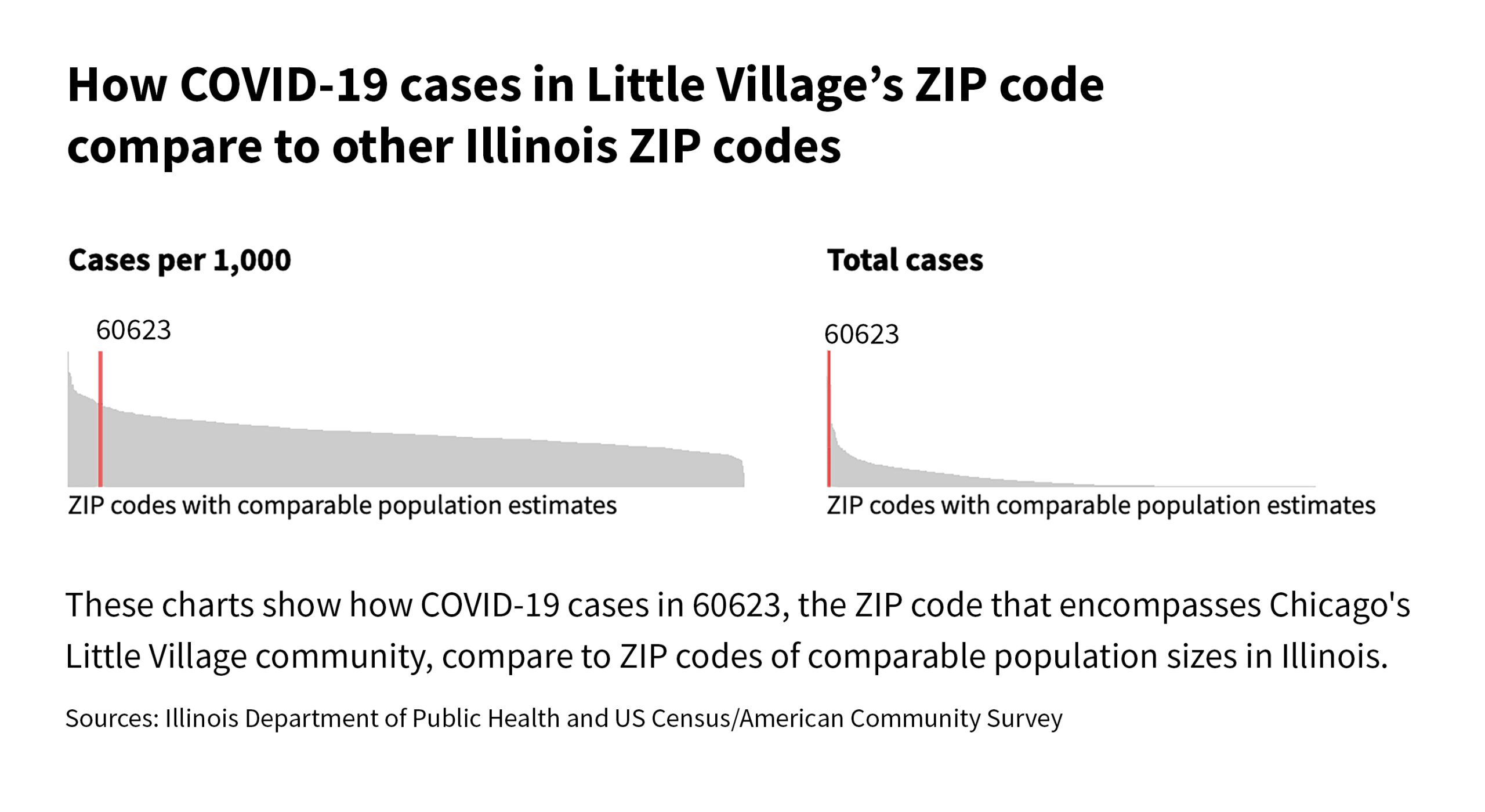
Para los alumnos de segundo curso de Contreras, era un momento crítico. En tercer curso, si los niños no saben leer ni hacer matemáticas, tienen más probabilidades de abandonar el instituto, vivir en la pobreza e ir a la cárcel. Además, los alumnos de Contreras son hispanohablantes. Tienen la presión añadida de aprender inglés.
Los responsables del distrito escolar pusieron de relieve la grave situación.
"Nuestros estudiantes están sufriendo ahora mismo, especialmente los más vulnerables", dijo la Directora General de Educación, Latanya McDade, en la reunión del Consejo de Educación de noviembre, señalando los datos que muestran que hay más estudiantes que suspenden que de costumbre. "Las consecuencias no son teóricas. La investigación nos dice que si no actuamos con urgencia estaremos en peligro de perder toda una generación de estudiantes."
Pero los alumnos de Contreras también tienen mucho a su favor. Su escuela está muy bien valorada y su director aprovecha todos los recursos para apoyar al personal y dar a los alumnos lo que necesitan. La mayoría tienen padres comprometidos que desean desesperadamente una buena educación para sus hijos.
Y tienen a Contreras. Es una profesora experimentada y decidida. También es inmigrante. Es estricta y empática a la vez. Aun así, está embrujada: ¿Será suficiente? ¿Lo lograrán sus alumnos?
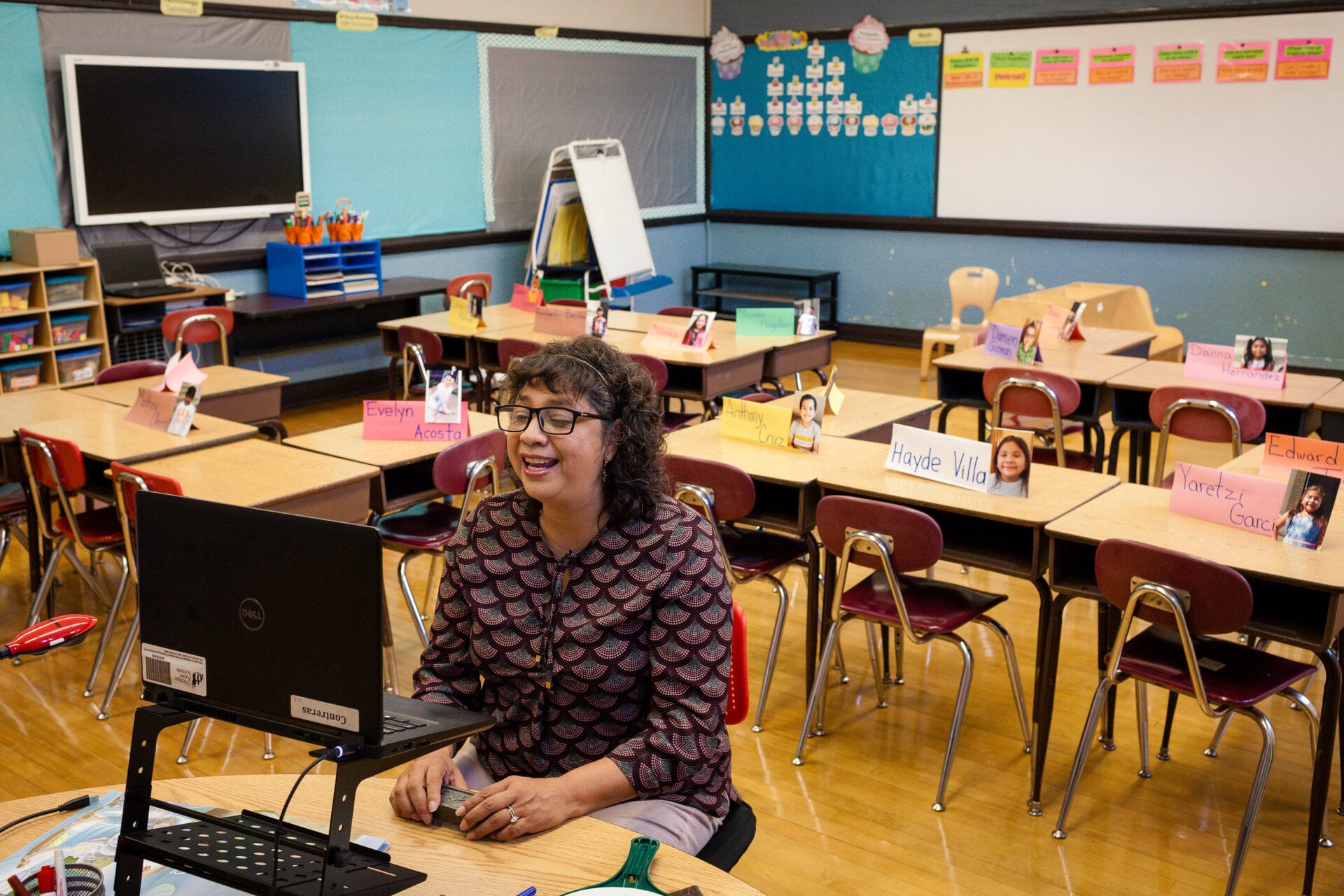
Olga Contreras empezó a enseñar a sus alumnos a distancia desde su aula de la Academia Escolar Saucedo en septiembre. No tiene pupitre de profesora porque normalmente está todo el día de un lado para otro. Este otoño, se sentó a la mesa de los niños. Michelle Kanaar / WBEZ
"Yo era uno de ellos"
Contreras se hizo una idea de lo difícil que iba a ser este año incluso antes de que empezaran las clases. En una jornada de puertas abiertas celebrada a finales de agosto en el amplio césped frente a Saucedo, Contreras dijo a los padres que los necesitaba. Quería que ayudaran a sus hijos a conectarse a la enseñanza a distancia y a controlar el tiempo. También les dio un paquete de libros de ejercicios.
Al final, la madre de María le dijo a Contreras que ella y su marido tenían que trabajar y no había nadie que les ayudara con la escolarización a distancia. Contreras sugirió la guardería que ofrecía el distrito escolar. Pero la madre dijo que dos miembros de su familia habían muerto de COVID-19. Tenía miedo de dejar a María en cualquier sitio. Le daba miedo dejar a María en cualquier sitio.
Contreras empujó a la madre: "¿Qué queremos para ella? ¿Queremos que se quede sentada delante de la tele?". Contreras pudo sentir el enfado de la mujer, no tanto contra ella, sino contra su vida profundamente alterada, dijo.
La madre de James, el niño cuyos ojos se iluminan en la oscuridad, no vino a recoger los cuadernos. Dijo que estaba demasiado ocupada. Como hizo con la madre de María, Contreras la culpó. Contreras tiene unos 50 años, edad suficiente para ser la madre de los padres.
"No puedes pedirle que esté en clase porque se va a sentir avergonzado", le dijo Contreras. "Eso es horrible para los niños". Finalmente, la madre vino a buscar los materiales. Contreras le dijo lo guapa que era y le dio las gracias. La actitud agria de la mujer se dulcificó un poco.
Contreras cree que la madre puede sentirse sola y abrumada. Está lejos de su Ecuador natal y aislada en su apartamento con al menos tres hijos. Le contó a Contreras que su marido trabaja muchas horas, seis días a la semana.
"Sé por lo que pasan los padres", dijo Contreras un día después de clase. "Yo fui uno de ellos".
Cuando Contreras llegó a Estados Unidos procedente de México, ella y su marido recogían fresas y luego trabajaban en fábricas de Chicago. Contreras dice que ella y su marido acabaron divorciándose tras un matrimonio problemático. Recuerda la nostalgia que sentía.
Contreras encontró un respiro trabajando como voluntaria en el preescolar de su hijo. "No hablaba inglés y me sentí muy acogida y contagiada", dice. Con el tiempo, Contreras fue contratada como ayudante de maestra y, siete años más tarde, se convirtió en profesora. También impulsó a sus tres hijos. Pasaron por las escuelas públicas de Chicago y todos se convirtieron en ingenieros.
Contreras está considerada una maestra, no sólo por cómo trabaja con los niños, sino también con los padres. Sin embargo, al abrir el ordenador este septiembre, Contreras se sintió como una novata.
Las instrucciones de las Escuelas Públicas de Chicago no eran compensar las pérdidas durante el cierre. En su lugar, se dijo a los profesores que se sumergieran en el material de nivel de grado. Acelerar el aprendizaje, no retroceder.
Contreras estaba de acuerdo, pero no confiaba en la enseñanza a distancia. Recibió formación sobre el uso de Google Suite. Con el tiempo, el distrito escolar también le proporcionó mejores equipos, como un soporte para portátiles y un proyector de documentos. Pero no le proporcionó lo que más necesitaba: formación sobre cómo conseguir que los alumnos se involucraran y se entusiasmaran con el aprendizaje en línea.
No conocía el estado emocional o académico de sus alumnos. Ni siquiera sabía si se presentarían. No tenía ni idea de qué esperar.
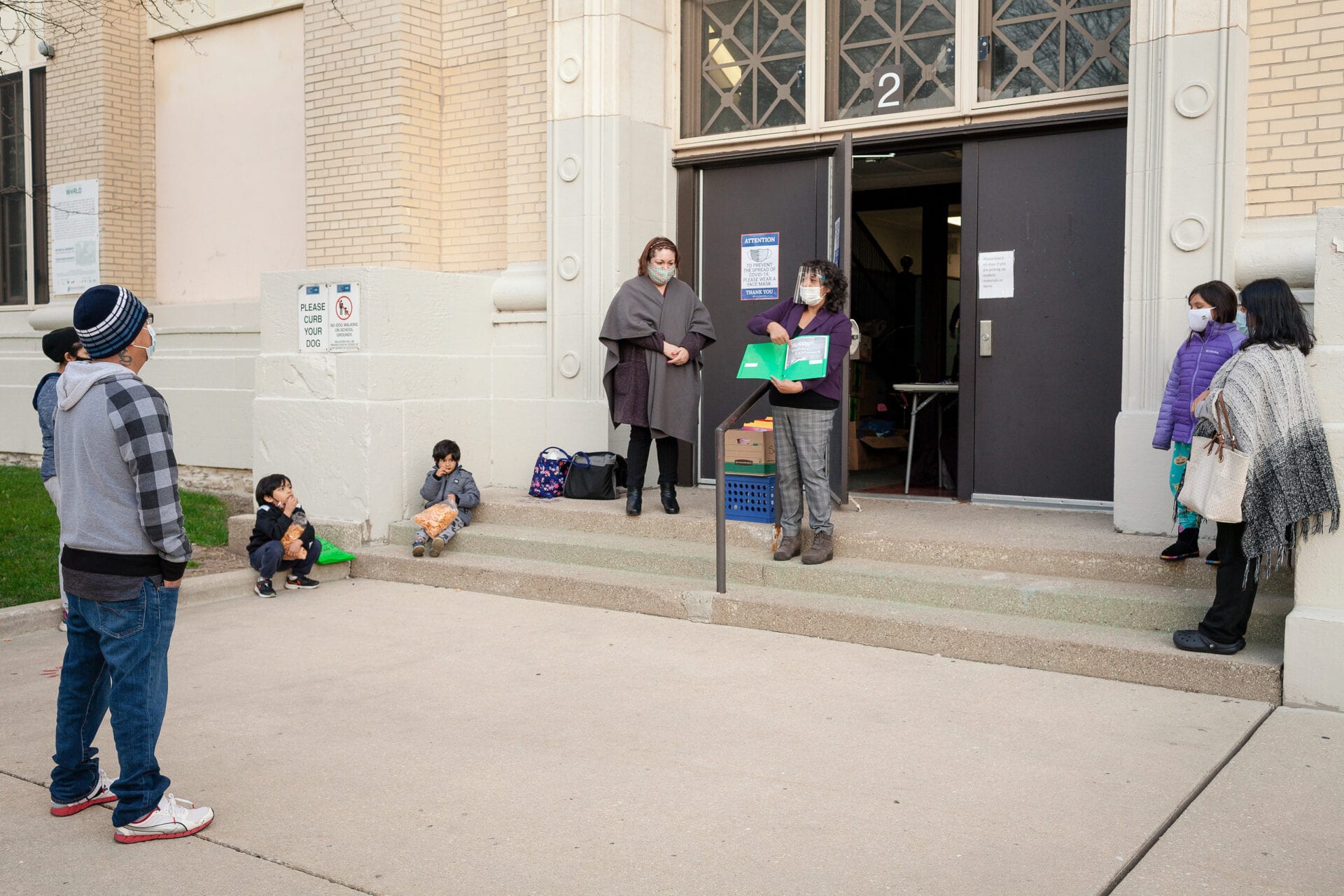
Contreras habla con padres y alumnos fuera de la escuela una tarde de noviembre. Insta a los padres a desempeñar un papel activo para ayudar a sus hijos durante el aprendizaje a distancia. Michelle Kanaar / WBEZ
Establecer conexiones
En la primera semana, sus alumnos, en su mayoría de 7 años, aún no sabían cómo silenciar y activar el micrófono. Durante varios días, un niño tuvo el micrófono encendido durante el intenso grupo de oración matinal de su madre. Mientras el Ave María retumbaba en español, Contreras no podía evitar reírse. "Los niños parecían muy confusos", dice.
Contreras pasó gran parte de la semana leyendo Stand Tall Molly Lou Melon. El libro trata de una niña morena que sufre acoso escolar por parte de un niño. Fue un punto de partida para hablar de la resiliencia y preguntar a los alumnos sobre los momentos en que se sintieron tristes.
"Estaba triste por no poder subirme a los toboganes este verano", dijo un niño en español. La mayoría de los niños le hablan en español y, sobre todo a principios de curso, Contreras imparte sus clases mayoritariamente en español.
"Sí", dijo Contreras, sabiendo que los parques infantiles están cerrados debido a la pandemia. "Tienes que convertirte en científico y hacer tu propio tobogán".
Otro niño, con una vocecita quejumbrosa, dijo que se sintió mal cuando murió su primo. Su abuela le frotó la espalda.
"Me alegro de que nos cuentes esto", le dijo Contreras. "Quizá puedas escribirle una carta y decirle cuánto le echas de menos".
Contreras tomó nota para ver si la familia quería que el niño hablara con alguien. Saucedo tiene un equipo socioemocional de 10 personas que incluye al orientador, un trabajador social y varios empleados de organizaciones externas traídos por el director.
Sobre todo al principio, Contreras se deshacía en elogios hacia los niños cada vez que hablaban. Los alumnos no pueden aprender si no se sienten seguros, decía. Buen trabajo, decía a menudo. "Buen trabajo, Jonathan. Buen trabajo, Yaretzi".
Pero después de la clase, Contreras compartió su preocupación por las respuestas de los alumnos a las preguntas en una sola palabra o en una frase corta. "Estaban más enganchados a la emoción del momento, pero no eran capaces de expresarla", explicó.
Contreras dijo que sospecha que han estado viendo demasiada televisión y teniendo pocas conversaciones con sus padres mientras están en casa durante la pandemia. Contreras lo atribuye en parte a la separación que existe en su cultura latina entre adultos y niños. Respetar a los mayores es primordial.
"En nuestra cultura son sólo órdenes", dijo Contreras. "Trae la sal. Haz los deberes. Cuida de tu hermanito. No hay mucho de 'háblame de esto'". Contreras recalcó que no está juzgando a los padres. Se trata de comprender sus orígenes.
Como profesora, sabe que las habilidades de conversación, es decir, poner en palabras pensamientos y argumentos, son fundamentales. Son la base del aprendizaje de la lectura y la escritura.
Aun así, Contreras ve una oportunidad. Muchos de los padres están en casa, muchos sentados detrás de sus hijos durante las clases. No tienen más remedio que participar, dice.
Ha ideado un plan para abrirse camino. Creará proyectos divertidos que los padres puedan hacer con sus hijos, proyectos que les hagan hablar.
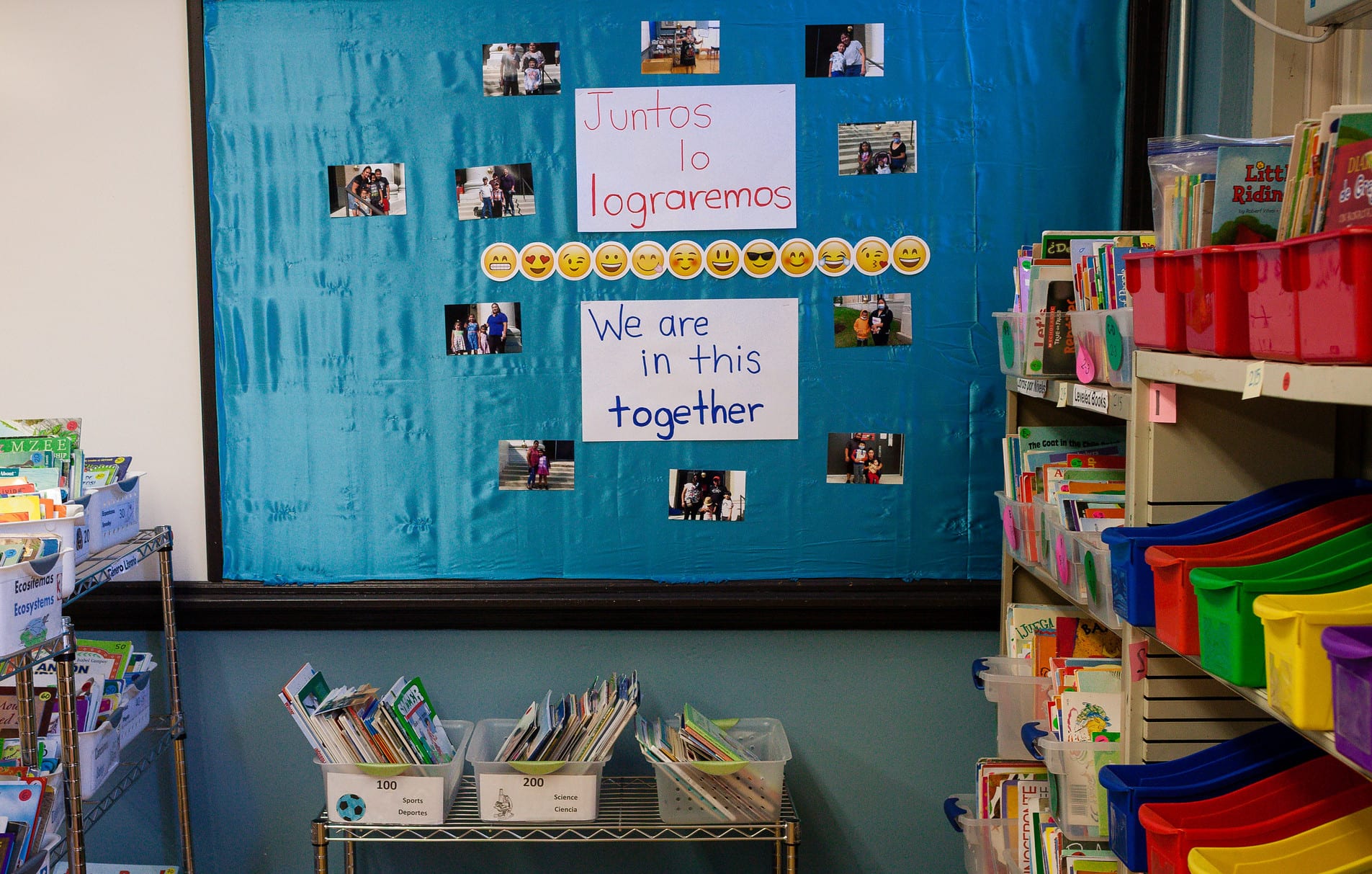
Para crear un sentimiento de comunidad, Contreras reunió un collage de fotos de sus alumnos y sus padres. Después de montar el aula, hizo una visita virtual a los alumnos. Michelle Kanaar / WBEZ
Pequeños abrazos virtuales
Para su primera tarea, pidió a sus alumnos que crearan un cartel que celebrara la familia y la cultura, y fue un éxito. Desde sus ordenadores en casa, los alumnos presentaron con entusiasmo lo que habían hecho a sus padres.
Un niño mostró a su tía de México, músico de mariachis, y sus dos equipos favoritos: el club de fútbol Guadalajara y el equipo de hockey Blackhawks. Su madre estaba a su lado, diciéndole lo que tenía que decir a continuación. Después de su presentación, los alumnos podían hacerle preguntas, pero la mayoría se limitaban a felicitarle. "Me encanta tu bandera", dijo un chico. "Gracias", respondió con una sonrisa orgullosa.
A Contreras le encantaban estos momentos de amabilidad. Eran como pequeños abrazos virtuales.
Casi todos los días, al menos un momento la impresionaba. Incluso los alumnos que más le preocupaban tenían momentos decisivos. Un día, la madre de James sorprendió a Contreras y dejó un mensaje de voz del niño contando. Antes de eso, el niño de un rincón oscuro nunca había hablado en clase. Contreras no sabía que sabía contar.
Si la ciencia fuera en persona, los alumnos de Contreras habrían pasado la mayor parte del primer trimestre en el jardín del colegio, aprendiendo sobre los hábitats. Así las cosas, envió a los niños fuera para que observaran. Mark, el niño que no puede estarse quieto en clase, se tranquilizó con los árboles y la hierba. Su madre envió a Contreras una foto suya sentado en una silla plegable a la sombra dibujando.
Cuando Contreras plantó dos semillas y puso una en el alféizar de la ventana y otra en el armario, una niña anunció que ya conocía los resultados del experimento. "Las semillas necesitan el sol para crecer", dijo.
Y Contreras tomó medidas para que la escuela a distancia se pareciera más a una escuela normal.
A las pocas semanas, transformó su habitación. Imprimió fotos que había hecho a los niños en la jornada de puertas abiertas y colocó una en cada escritorio. Decoró los tablones de anuncios. Luego hizo una visita virtual de la habitación. Los niños estaban encantados y señalaron sus decoraciones favoritas. Les dijo que el aula les estaba esperando.

Contreras imprimió fotos que hizo a los alumnos en una jornada de puertas abiertas y colocó una en cada pupitre. Michelle Kanaar / WBEZ
Una base inestable
Al principio del trimestre, preguntó a los alumnos si sabían leer 90 palabras. Eso es lo que se espera al empezar segundo curso. El resultado del primer alumno fue de apenas 23 palabras. De los otros 10, sólo uno superó las 90. Los seis últimos alumnos no tenían nada junto a su nombre. No sabían leer ni una sola palabra.
Algunos expertos en educación sostienen que los riesgos no son especialmente grandes para los estudiantes con déficits este otoño. Según Rebeca Itzkowich, instructora del Instituto Erikson, una organización de Chicago que estudia y ofrece formación en educación infantil, si la base del alumno es sólida, debería ser capaz de recuperar las destrezas con bastante facilidad. Dijo que si recibieron una instrucción sólida hasta marzo, deberían estar bien. "Una vez que aprendes algo, nadie te lo puede quitar, aunque no estés en la escuela", dijo.
Pero no todos los alumnos salieron de la escuela en marzo con una base sólida. De hecho, incluso en un año normal, la mitad de los alumnos de segundo curso de las Escuelas Públicas de Chicago obtienen resultados por debajo de las normas nacionales. En octavo, unos 70% cumplen las normas, así que, aunque muchos se ponen al día, un número significativo no lo hace. Algunas escuelas están mucho peor. Saucedo está en la media.
Y las clases normales no fueron lo único que se interrumpió. Por ejemplo, Mark. Durante la clase, a veces se pone de pie sobre su silla o corre alrededor de ella. Una vez incluso se puso de pie delante de la pantalla. Un día, su madre llegó al colegio angustiada. "Puede responder a tus preguntas, pero no presta atención", le dijo a Contreras. Contreras asintió con la cabeza y le sugirió que le regalara una pelota antiestrés.
Pero Contreras sabe que necesita más. Tiene dos alumnos con dificultades de aprendizaje diagnosticadas y otros que reciben ayuda con el habla. Estos alumnos no recibieron apoyo adicional ni en primavera ni en verano, como suelen hacer muchos estudiantes de educación especial. Este otoño, los clínicos y un profesor de educación especial trabajaron con los alumnos por separado en línea. Pero, al igual que la pelota antiestrés, no es suficiente.
A Contreras también le preocupa que los alumnos no trabajen por su cuenta. Van a clase, pero muchos no hacen las dos horas diarias de lectura y matemáticas que se esperan de ellos sin su profesor. Eso significa que en lugar de las seis horas de instrucción que recibirían en tiempos normales, sólo reciben tres.
Esto se produce cuando las probabilidades de volver a la escuela presencial disminuyen cada día que pasa.
A medida que avanzaba el otoño, el número de casos de COVID-19 seguía aumentando. Una vez más, Little Village se convirtió en un punto caliente. Fuera de Saucedo, el aparcamiento de la escuela es un lugar de pruebas. Las colas se habían reducido a un goteo en agosto, pero a mediados de otoño los coches que esperaban para someterse a las pruebas ocupaban varias manzanas.
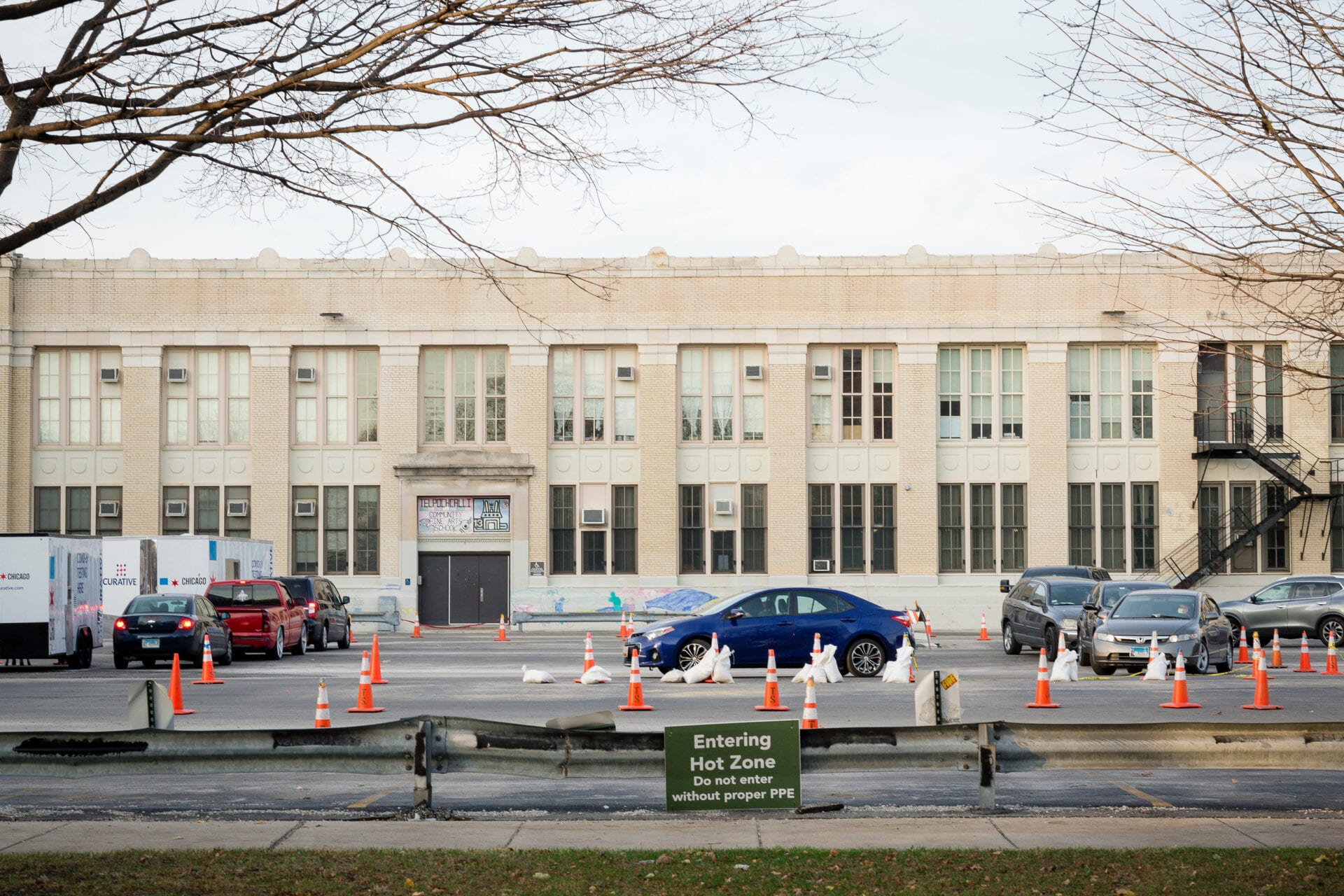
Desde mayo, el aparcamiento de Saucedo se ha transformado en uno de los centros de pruebas gratuitas de la ciudad. Este otoño, la cola de coches esperando para someterse a las pruebas a menudo se extendía a lo largo de varias manzanas. Michelle Kanaar / WBEZ
Los padres junto a los alumnos
Durante todo el otoño, a Contreras se le ocurrían constantemente nuevas ideas para proyectos que sus alumnos pudieran hacer en casa con sus padres. Para matemáticas, tal vez recetas. Para la unidad de ciencias sobre materiales, tal vez hacer piñatas. Pero dudaba.
"Ser consciente de que los padres tienen estos problemas financieros", dijo. "Eso me rompe el corazón. No quiero pedir más". Los profesores de Chicago sólo recibieron este año su estipendio ordinario de $250.
Contreras se dio cuenta de que los padres estaban presentes en casa junto a las madres. Para ella, era señal de que tal vez nadie en el hogar tenía trabajo. A Contreras esto le preocupaba especialmente. Se imaginaba que el estrés se acumulaba en torno a sus alumnos.
Aunque Contreras necesitaba a los padres allí, su presencia también era una fuente de tensión. Un día Contreras le pidió a una niña que se quedara después de clase para leerle. Cuando la niña, súper tímida, dudó, se vio a su madre en Google Classroom pegándole. Contreras sospecha que la madre está enfadada porque la niña tiene muchos problemas. Contreras se reunió con la madre y le rogó que dejara en paz a la niña.
Luego están los niños cuyos padres no son tan atentos. María, la niña a la que su madre amenazó con no escolarizar, a menudo parece estar sola en el lugar de trabajo de sus padres. Contreras cree que la niña sabe jugar en su ordenador y no presta atención. Tal vez esa niña piense que no le importa a nadie, dice Contreras.
Luego está James. Su madre lo intenta, pero cuando desenmudece su micrófono, el ruido es intenso. Había charlas de otras aulas y su hermana pequeña correteaba. Contreras le prestó un pupitre de Saucedo para que tuviera un lugar donde trabajar.Si estaba en su clase delante de ella, Contreras dijo que le prestaba mucha atención individual. Le abrazaba. "Quiero hacer un cambio en su vida, quiero que vea que puede lograrlo. Pero necesita mucho afecto y sólo puedo dárselo en persona", dijo.
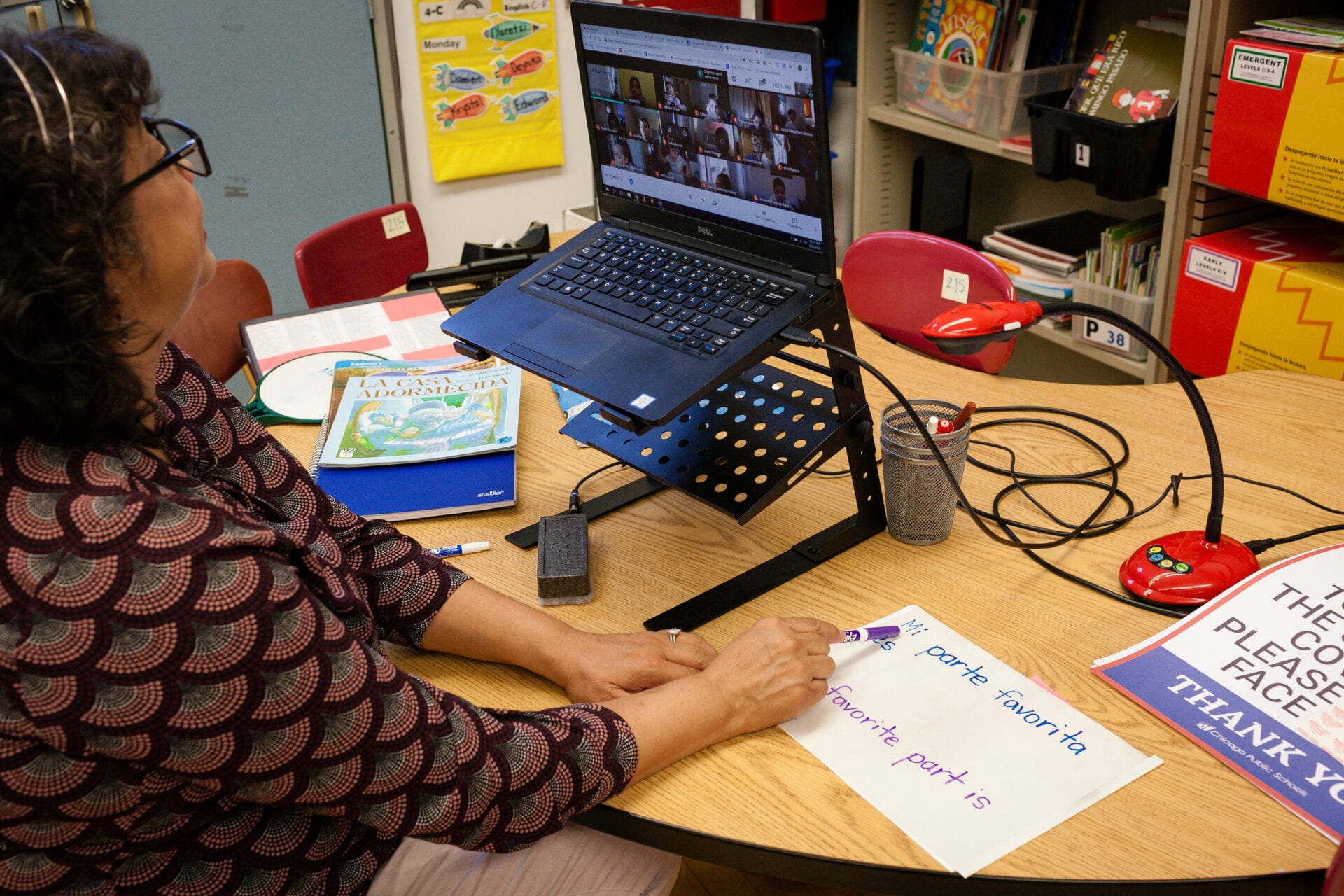
Contreras se acostumbró a enseñar a distancia a medida que avanzaba el otoño. Consiguió una cámara de documentos que le permite mostrar el trabajo de sus alumnos en tiempo real. Michelle Kanaar / WBEZ
Una brecha académica cada vez mayor
La pasada primavera, investigadores y otros expertos hicieron sonar las alarmas sobre las previsiones de enormes pérdidas de aprendizaje relacionadas con la pandemia. Varios estudios realizados a partir de pruebas realizadas este otoño muestran su impacto en la vida real. Uno de ellos, realizado por la consultora McKinsey & Co., descubrió que los estudiantes perdían por término medio un mes y medio en lectura y tres meses en matemáticas. Y lo que es más importante, los estudiantes negros y latinos sufrieron pérdidas mucho más significativas.
Las escuelas públicas de Chicago cancelaron todos los exámenes estandarizados este otoño, pero los distritos escolares que han sometido a sus alumnos a pruebas están viendo cómo se desarrolla esta situación. En Dallas, el superintendente calificó los resultados de una prueba estandarizada realizada este otoño de "horrible." La mitad de los estudiantes perdieron terreno en matemáticas y un tercio en lectura, y los estudiantes negros y latinos obtuvieron resultados mucho peores que los blancos. Se obtuvieron resultados similares en una prueba de alfabetización temprana realizada a alumnos de Washington, D.C. - alumnos como los de la clase de Contreras.
Si no se abordan, estas pérdidas se agravarán, afirma Bryan Hancock, socio de McKinsey. Se teme que los alumnos de familias de clase media y media-alta salgan indemnes de la pandemia, y que aumente la ya considerable diferencia entre su rendimiento y el de los alumnos pobres.
Algunos profesores de las Escuelas Públicas de Chicago dicen que están viendo esta disparidad. Uno enseña en una escuela diversa del barrio de clase media alta de Hyde Park. En primavera y verano, estos niños pasaban tiempo con los libros y hablando con sus padres. Este otoño, sus padres están con ellos, enseñando junto al profesor.
"Es casi como educar en casa con mucha orientación y dirección", dice Gabriel Sheridan, que tiene una clase dividida de primer y segundo curso en la escuela primaria Ray. "Para esos niños puede ser muy exitoso porque tienen a alguien allí para ayudarles a sacarlo adelante". Pero ella también ve la división. Tiene un niño sin mucho apoyo y está flaqueando.
Entonces, ¿qué ocurre si los alumnos salen de la pandemia aún más separados de lo que ya estaban?
Contreras tiene una opinión al respecto. No cree que sus alumnos -hijos de familias inmigrantes pobres- vayan a tener mucho margen de maniobra. Eso es lo que la motiva. Eso es lo que le quita el sueño.

La directora de Saucedo colocó estos carteles por toda la escuela. Dice que aunque los alumnos no estén allí, quiere que las familias sepan que siguen formando parte de la comunidad. Michelle Kanaar / WBEZ
Medir el impacto de la pandemia
Durante el otoño, Contreras tuvo la sensación de ir a ciegas. Necesitaba saber exactamente cuáles eran los problemas de sus alumnos. Decidió hacerles un examen estandarizado, a pesar de que ni las Escuelas Públicas de Chicago ni su director se lo exigían.
"Va a mostrar cómo mi enseñanza ... buena o mala, si estoy produciendo o no", dijo Contreras en la sexta semana del trimestre de nueve semanas. "Digamos que [James] está en el nivel A. No sabe leer. Si estamos a mitad de año y él está en el nivel A. Hombre ..."
Los resultados fueron incluso peores de lo que temía.
Casi al final del primer trimestre, a finales de octubre, convocó una reunión de padres. Una reunión muy importante, les dijo.
Esto es lo que les dijo: No había un solo estudiante en la clase que leyera al nivel del grado o por encima.
"Cero. Cero", dijo Contreras. En español, dijo que por lo general al menos la mitad de sus estudiantes leen en o por encima del nivel de grado. "Esta vez, ha sido cero".
Pero inmediatamente cambió de rumbo para ofrecer esperanza. No es culpa vuestra, les dijo. Es culpa de la pandemia. Tienen que animar a sus hijos a leer y escribir, y tienen que hacerlo con ellos.
Y respirando hondo, terminó con esto: "Estoy muy emocionada, padres, porque éste es un momento histórico para todos. Como padres, como hijos, como profesores, podemos vencer a la pandemia".
A continuación, pregunta si hay preguntas. No hay ninguna.
Reagruparse y avanzar
Contreras cree que los padres no la cuestionaron porque confían en ella. Es la profesora. Ella sabrá cómo arreglarlo.
Y Contreras tenía un plan de juego.
Dividía a los alumnos en cuatro grupos pequeños, cada uno dirigido por un adulto distinto: ella misma, el profesor en prácticas, el profesor de educación especial y un ayudante de profesor. Los alumnos recibían mucha atención individual.
Pero su ambicioso plan sufrió un revés antes de ponerse en marcha.
La profesora de educación especial se trasladó a otro colegio. No sólo ya no se podía dividir la clase en cuatro partes, sino que su profesor sustituto de educación especial no era bilingüe.
Contreras se enfadó al principio. Escasean los buenos profesores de educación especial, sobre todo los que hablan español. De hecho, las Escuelas Públicas de Chicago siguen buscando cubrir 260 puestos vacantes a 1 de diciembre. Eso es alrededor de 6% de los 4.600 puestos de maestros de educación especial en el distrito.
Pero rápidamente, Contreras ideó un nuevo plan. Se hizo cargo de la mitad de la clase, mientras que su profesora en prácticas y la ayudante del profesor se repartieron los ocho alumnos restantes con peores resultados. No era lo ideal, pero Contreras tenía que seguir adelante.
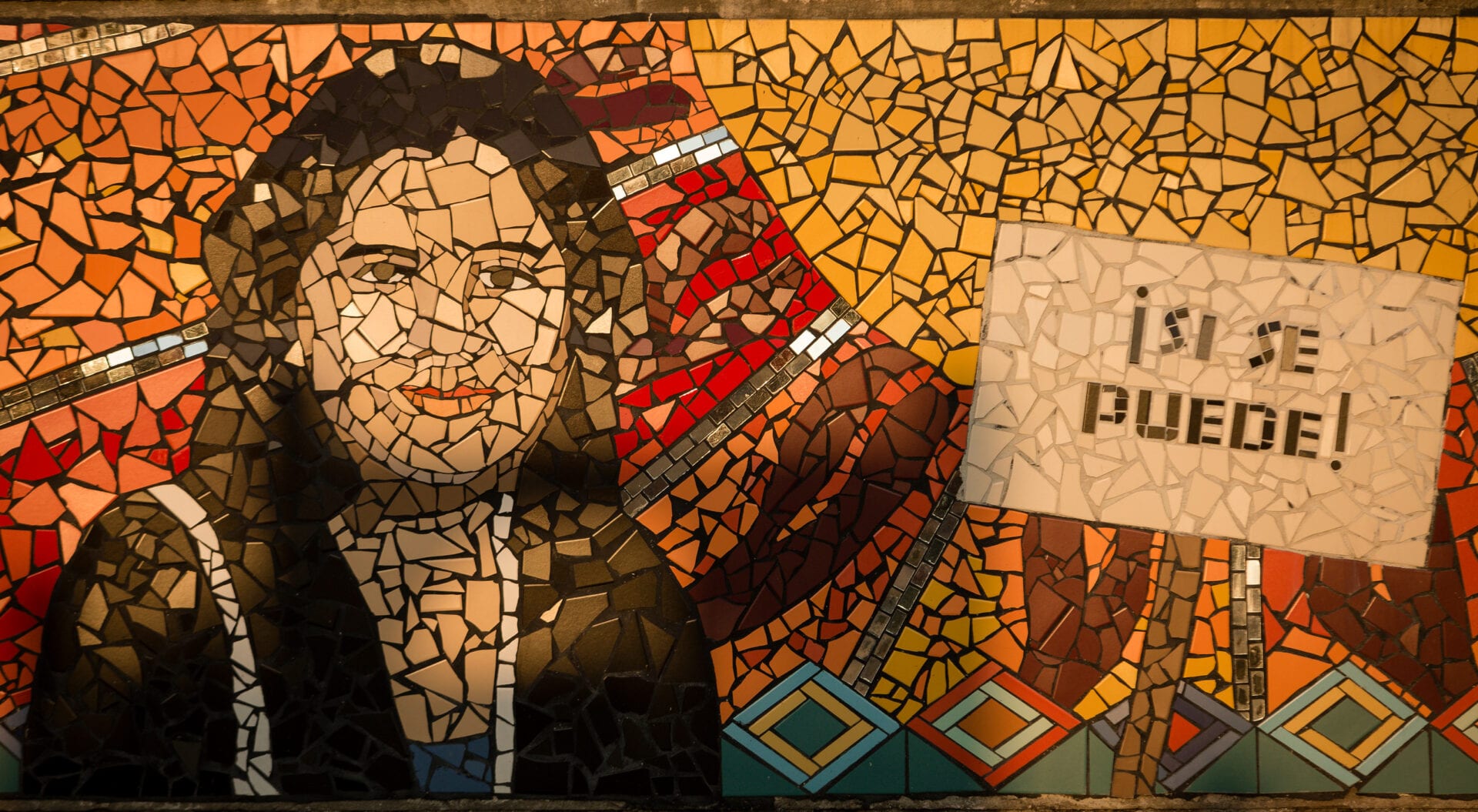
En un mural del campus de Saucedo se puede leer "¡Sí se puede!" en español. Alrededor del 40% de los alumnos están aprendiendo inglés. Michelle Kanaar / WBEZ
Acortar distancias
A medida que el trimestre se acercaba a su fin, a principios de noviembre, Contreras seguía decidida. Cada día tiene muchas victorias. Niños tímidos que hablan. Conversaciones improvisadas. Niños dispuestos a hacer el tonto. Eso le hace saber que se sienten seguros.
James se sienta en el escritorio que ella le regaló. Incluso ha puesto un cuadro en la pared detrás que pone "Saucedo". Marcos juega con un juguete durante la clase para mantener la concentración. Los padres de María se reúnen con Contreras. Intenta hacerles ver que María necesita más atención.
El director tiene 400 auriculares nuevos para los alumnos y está haciendo entrevistas para el puesto de educación especial. Contreras confía en que el director encuentre a alguien bueno.
Sin embargo, Contreras no puede ocultar su preocupación. La pandemia está empeorando. Nunca ha habido tanta gente en el centro de pruebas de la escuela. Cada vez más madres y padres le dicen que se están sometiendo a las pruebas o que sus familiares están enfermos o incluso han muerto. Las empresas vuelven a cerrar, con la consiguiente pérdida de puestos de trabajo.
Sabe que sus alumnos sienten todo esto.
El distrito escolar anunció que los alumnos de primaria volverían a la enseñanza presencial el 1 de febrero. Como a la mayoría de los profesores, a Contreras nada le gustaría más que ver a sus alumnos, pero se muestra escéptica ante la posibilidad de que eso ocurra pronto.
Contreras hace todo lo que puede, pero teme que no sea suficiente, especialmente para estudiantes como James y María. Lo que realmente necesitan es que alguien les abrace y les diga que pueden lograrlo, afirma.
Ahora mismo, la distancia entre ellos parece demasiado grande.
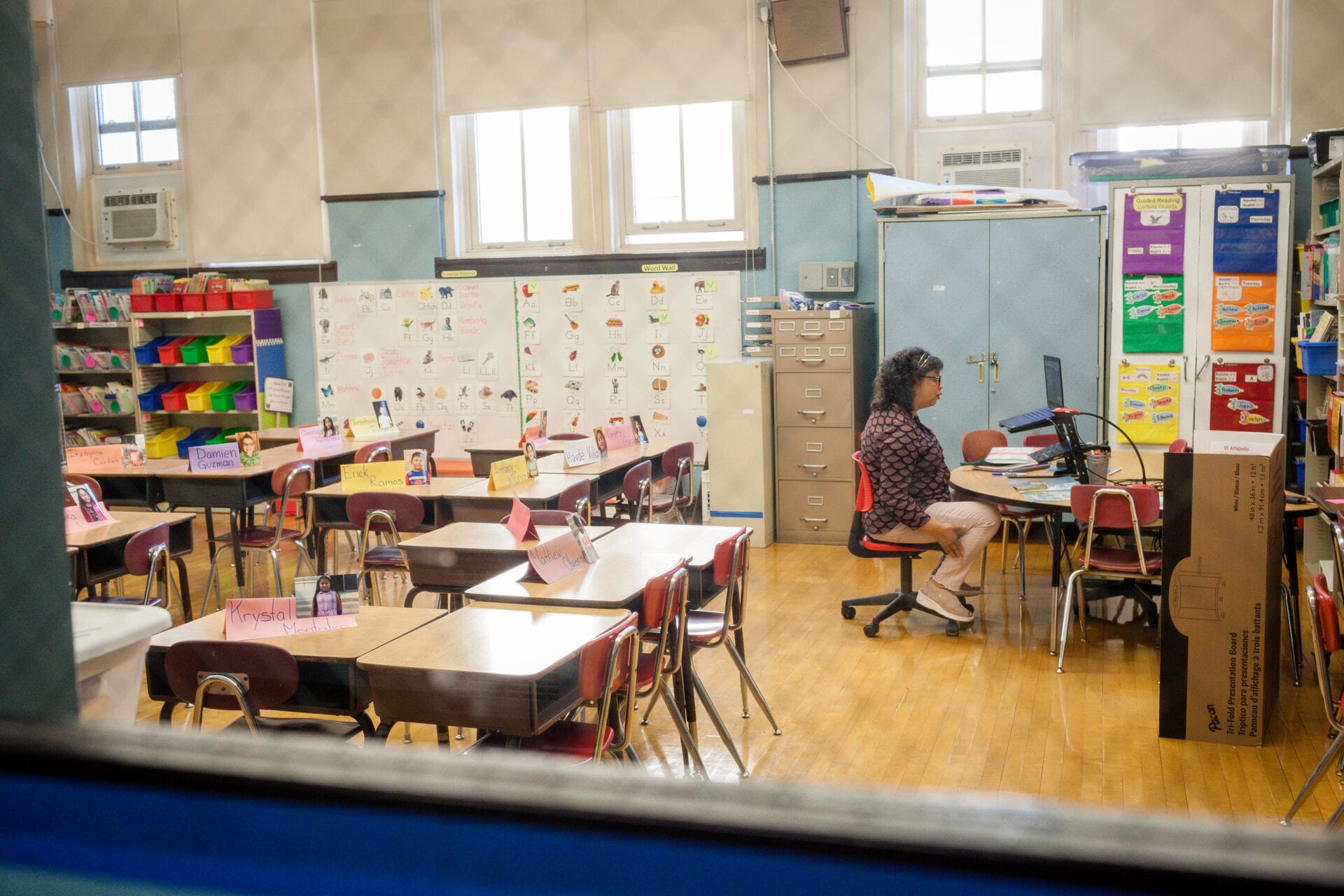
Contreras terminó el trimestre de otoño sabiendo lo atrasados que están sus alumnos, pero también sintiéndose esperanzada sobre lo que podrían conseguir este curso escolar. Michelle Kanaar / WBEZ
Sarah Karp informa sobre educación para WBEZ. Sígala en Twitter @WBEZeducación y @sskedreporter. La historia fue editada por Kate Grossman y Cate Cahan. El diseño de producción y los gráficos son de Katherine Nagasawa. Justin Bull se encargó de la banda sonora y la mezcla. Fotos de Michelle Kanaar.
Este reportaje se ha realizado con el apoyo del Fondo para el Periodismo sobre el Bienestar Infantil, un programa de la USC Annenberg. Centro de Periodismo Sanitario Beca Nacional 2020.
